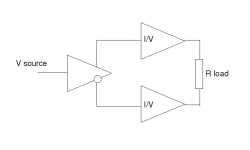Has this been done?
I (very) quick google search showed no useful hits, so my assumption is that this has either not been thought of (unlikely) or is fundamentally flawed.
I was toying with the idea of two LM3886 chip amps, bridged, operating in current mode, but realized the drawbacks of the idea - i.e. very high tolerance gain matching and offset adjustment required, or some form of compensation for the asymmetric output current of each half of the bridge.
What do people think?
I (very) quick google search showed no useful hits, so my assumption is that this has either not been thought of (unlikely) or is fundamentally flawed.
I was toying with the idea of two LM3886 chip amps, bridged, operating in current mode, but realized the drawbacks of the idea - i.e. very high tolerance gain matching and offset adjustment required, or some form of compensation for the asymmetric output current of each half of the bridge.
What do people think?
http://www.national.com/an/AN/AN-1192.pdf
Hi,
parellel and bridged/ parallel have been done,
bridged is not that useful for real speaker loads.
Cannot see the point of a V to I amplifier for normal speakers.
🙂/sreten.
Hi,
parellel and bridged/ parallel have been done,
bridged is not that useful for real speaker loads.
Cannot see the point of a V to I amplifier for normal speakers.
🙂/sreten.
Yep - bridging is as old as the earth, I wasn't suggesting anything new there.
Just wondering if anyone had bridged AND current-driven in the same circuit (as per my original question).
The main reason for current drive is to lower distortion - there are plenty of papers (by Hawksford, et all) that describe it (just google).
The benefit of using both would be higher output power from low power rails whilst lowering distortion - the problems (as originally stated) would be the requirement to either ensure perfectly balanced amplifiers, or compensate somehow.
Just wondering if anyone had bridged AND current-driven in the same circuit (as per my original question).
The main reason for current drive is to lower distortion - there are plenty of papers (by Hawksford, et all) that describe it (just google).
The benefit of using both would be higher output power from low power rails whilst lowering distortion - the problems (as originally stated) would be the requirement to either ensure perfectly balanced amplifiers, or compensate somehow.
Hi,
You mean feedforward topologies / current dumping ?
I still do not know what you are on about, how can you bridge
and balance at the same time without a further two amplifiers ?
🙂/sreten.
You mean feedforward topologies / current dumping ?
I still do not know what you are on about, how can you bridge
and balance at the same time without a further two amplifiers ?
🙂/sreten.
Would you like to offer a diagram of what you have in mind? Yes, there are advantages to current drive for loudspeakers (eliminates power compression by definition, reduces distortion) but there are also problems. All commercial loudspeakers assume voltage drive, so if you want to use current drive you need to design the loudspeaker in that way from the ground up.
Bridging probably does make sense in current drive because you're likely to need a larger voltage swing than with voltage drive.
Bridging probably does make sense in current drive because you're likely to need a larger voltage swing than with voltage drive.
sreten said:Hi,
I still do not know what you are on about, how can you bridge
and balance at the same time without a further two amplifiers ?
🙂/sreten.
Simple 🙂
Bridged - two amplifiers operating in opposite polarity, one per driver connection.
Current drive - the above mentioned amplifiers have transconductance output stages.
The idea is very simple, yet possibly difficult to explain - I've just migrated to Linux, so I might be a while before I can knock up a diagram.
Hopefully the diagram will explain better the problems I can see with the idea.
Stay tuned...
series current sources = bad idea
2 ideal current sources with infinitesimal difference of I settings in series will have a Voltage compliance "catastrophe" - just like 2 ideal Voltage sources in parallel result in infinite current
a "current output" amplifier has high output impedance - any mismatch between the two bridge output's impedances or current gain/offset results in asymmetric V splitting between the 2 outputs so identical bridged current outputs are difficult to make work
driving the load with one current drive amp, and inverting the V at the speaker terminal to drive the other speaker terminal with a low impedance V output amplifier does increase the compliance V - but the fundamentally different operating modes of the two amps in this "bridge" may not have the even harmonic distortion cancellation properties of two V output bridged amps
2 ideal current sources with infinitesimal difference of I settings in series will have a Voltage compliance "catastrophe" - just like 2 ideal Voltage sources in parallel result in infinite current
a "current output" amplifier has high output impedance - any mismatch between the two bridge output's impedances or current gain/offset results in asymmetric V splitting between the 2 outputs so identical bridged current outputs are difficult to make work
driving the load with one current drive amp, and inverting the V at the speaker terminal to drive the other speaker terminal with a low impedance V output amplifier does increase the compliance V - but the fundamentally different operating modes of the two amps in this "bridge" may not have the even harmonic distortion cancellation properties of two V output bridged amps
- Status
- Not open for further replies.
- Home
- Source & Line
- Analog Line Level
- Bridged current-drive amp?
